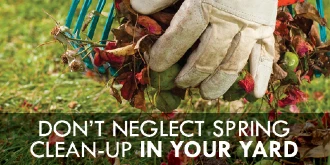Spring Spruce-Up
As warm days become commonplace and perennials start poking through the soil, it’s clear that spring is almost here! If you want your lawn to look beautiful and provide a place to relax and play this summer, you can’t neglect spring clean-up. Here are the steps you must take during the month of March to achieve the summertime lawn and garden you crave.

Prevent Spring Weeds
Dandelions, crabgrass, and clover are all weeds you don’t want in your yard. To avoid back-breaking weed-pulling later in the season, treat your lawn now with pre-emergent herbicide and stop weeds from germinating in the first place. Be aware that many brands of pre-emergent herbicide prevent all seeds from germinating, so avoid applying grass seed for six to 12 weeks following application.
Timing is everything when it comes to making the most of your weed prevention efforts. If you live in a region where forsythia grows (Hardiness Zones 5-8), wait until you see their yellow flowers bloom. This is your clue that the soil temperature has reached 13 degrees Celsius and weeds will be germinating soon in the warmer weather.
Aeration
The soil in your yard naturally compacts as time goes by. Aerating allows more water, air, and nutrients to enter the soil so your grass grows deeper, more drought-resistant roots. Consider aerating your lawn up to once a year if it puts up with heavy foot traffic.
For the best results, use a plug aerator, which removes one-half inch wide plugs of soil two to three inches deep all over your lawn. If you choose to complete this task yourself, follow these tips:
- Water your lawn the day before aerating.
- Pass once over the whole yard and make multiple passes over especially compacted areas.
- Leave the excavated soil plugs on the lawn to dry. After a few days, break them up with a lawnmower or the back of a rake.
- Continue to fertilize, mow, and water your lawn like normal.
Dethatching
The layer of dead grass that accumulates just above the soil is called thatch. In small amounts, this dead grass is beneficial, but when too much thatch builds up, it prevents water and air from reaching the roots. To prevent the widespread brown patches that can result, dethatch your lawn as part of your spring clean-up.
If you have only a small patch of grass to dethatch, a convex rake is an adequate tool. For larger areas, it’s worth renting a power rake, also known as a vertical cutter. No matter what tool you use, follow these tips:
- Water your lawn the day before dethatching.
- Mow your grass to half its normal height.
- Flag sprinkler heads and other hidden objects so you can easily avoid them.
- Dethatch in two directions at a 90-degree angle from one another.
- If dethatching leaves bare spots, reseed your lawn.
- Water the lawn well to help the grass recover.
Fertilizing
Your lawn needs the proper nutrients to stay healthy and green. Some nutrients – including nitrogen, phosphorus, and potassium – could be in short supply, depending on the composition of your soil. Fertilizer acts like a vitamin supplement for plants, providing the nutrients necessary to promote green leaves, deep roots, large seeds, and an overall healthy appearance.
Selecting the right fertilizer makes all the difference. The type you choose for your lawn depends on existing soil composition and the type of grass you have.
Pruning
Chopping branches off your prized plants may seem cruel, but pruning is vital for keeping trees and shrubs healthy. Proper pruning helps them grow thick and produce more flowers and fruit.
Different plants have specific pruning needs, including timing, how much to cut back, and which pruning methods work best. In fact, some plants actually require little to no pruning. Before you get too shear-happy, it’s wise to consult with an expert about your garden’s pruning needs.
Mulching
Your garden will thank you for adding mulch to your flower beds and around the base of trees. Mulching protects roots from heat damage, slows evaporation, reduces erosion, and helps prevent weeds from sprouting. The type of mulch you choose – from organic materials like bark to inorganic options like gravel or rubber – impacts the appearance of your garden and how often you must replace the mulch.
Let The Grounds Guys® Help with Your Spring Clean-Up
Transitioning your yard from winter dormancy to the spring growing season is no small task. If you don’t have the time, energy, or resources to complete the job yourself, The Grounds Guys can help. We offer residential yard clean-up services as well as spring spruce-up services for commercial properties.
For more tips to prepare your garden for spring, or to schedule clean-up services from The Grounds Guys, please contact us today!
 Click to call
Click to call


